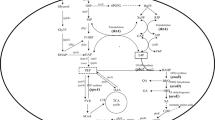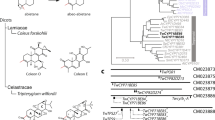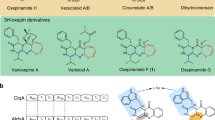Abstract
Microbial transformation is known to be one of promising options to add functional groups such as a hydroxyl moiety to active base compounds to generate their derivatives. Sordaricin, a diterpene aglycone of the natural product sordarin, is an antifungal agent to selectively inhibit fungal protein synthesis by stabilizing the ribosome/EF-2 (elongation factor 2) complex. We screened actinomycetes to catalyze hydroxylation of sordaricin on the basis that the hydroxyl moiety would make it easier to generate derivatives of sordaricin. As a result of the screening, 6-hydroxylation of sordaricin was found to be catalyzed by Lentzea sp. 7887. We found that the cytochrome P450 inhibitor metyrapone inhibited this reaction, suggesting that a cytochrome P450 may be responsible for the biotransformation. As a next step, we cloned multiple cytochrome P450 genes, one of which were named P450Lent4B11, using degenerate PCR primers. The expressed cytochrome P450 derived from the P450Lent4B11 gene provided a different absorbance spectrum pattern from original one when it was incubated with sordaricin. Moreover, in cell-free conditions, the corresponding cytochrome P450 displayed the 6-hydroxylation activity toward sordaricin. Taken together, these results indicate that P450Lent4B11, derived from Lentzea sp. 7887, should be responsible for catalyzing 6-hydroxylation of sordaricin.
This is a preview of subscription content, access via your institution
Access options
Subscribe to this journal
Receive 12 print issues and online access
$259.00 per year
only $21.58 per issue
Buy this article
- Purchase on Springer Link
- Instant access to full article PDF
Prices may be subject to local taxes which are calculated during checkout





Similar content being viewed by others
References
Lockhart SR, Guarner J. Emerging and reemerging fungal infections. Semin Diagn Pathol. 2019. https://doi.org/10.1053/j.semdp.2019.04.010.
Orlowski HLP, et al. Imaging spectrum of invasive fungal and fungal-like infections. Radiographics. 2017;37:1119–34.
Fernández-García R, de Pablo E, Ballesteros MP, Serrano DR. Unmet clinical needs in the treatment of systemic fungal infections: the role of amphotericin B and drug targeting. Int J Pharm. 2017;525:139–48.
Roemer T, Krysan DJ. Antifungal drug development: challenges, unmet clinical needs, and new approaches. Cold Spring Harb Perspect Med. 2014;4:a019703 https://doi.org/10.1101/cshperspect.a019703
Hauser D, Sigg HP. Isolation and decomposition of sordarin. Helv Chim Acta. 1971;54:1178–90.
Liang H. Sordarin, an antifungal agent with a unique mode of action. Beilstein J Org Chem. 2008. https://doi.org/10.3762/bjoc.4.31.
Arai M, Harasaki T, Fukuoka T, Kaneko S, Konosu T. Synthesis and evaluation of novel pyrrolidinyl sordaricin derivatives as antifungal agents. Bioorg Med Chem Lett. 2002;12:2733–6.
Kaneko S, et al. Synthesis of Sordaricin analogues as potent antifungal agents against Candida albicans. Bioorg Med Chem Lett. 2002;12:803–6.
Quesnelle CA, et al. Sordaricin antifungal agents. Bioorg Med Chem Lett. 2003;13:519–24.
Regueiro-Ren A, et al. Core-modified sordaricin derivatives: synthesis and antifungal activity. Bioorg Med Chem Lett. 2002;12:3403–5.
Sasamura S, et al. Bioconversion of FR901459, a novel derivative of cyclosporin A, by Lentzea sp. 7887. J Antibiot. 2015;68:511–20.
Parker JD, Rabinovitch PS, Burmer GC. Targeted gene walking polymerase chain reaction. Nucleic Acids Res. 1991;19:3055–60.
Schenkman JB, Jansson I. Spectral analyses of cytochromes P450. Methods Mol Biol. 2006;320:11–8.
Unger BP, Gunsalus IC, Sligar SG. Nucleotide sequence of the Pseudomonas putida cytochrome P-450cam gene and its expression in Escherichia coli. J Biol Chem. 1986;261:1158–63.
Ravichandran KG, Boddupalli SS, Hasermann CA, Peterson JA, Deisenhofer J. Crystal structure of hemoprotein domain of P450BM-3, a prototype for microsomal P450’s. Science. 1993;261:731–6.
Hasemann CA, Kurumbail RG, Boddupalli SS, Peterson JA, Deisenhofer J. Structure and function of cytochromes P450: a comparative analysis of three crystal structures. Structure. 1995;3:41–62.
Brown GD, et al. Hidden killers: human fungal infections. Sci Transl Med. 2012;4:165rv13.
Spivak ES, Hanson KE. Candida auris: an emerging fungal pathogen. J Clin Microbiol. 2018;56:e01588–17. https://doi.org/10.1128/JCM.01588-17
Sakaki T, et al. Bioconversion of vitamin D to its active form by bacterial or mammalian cytochrome P450. Biochim Biophys Acta. 2011;1814:249–56.
Ma L, et al. Reconstitution of the in vitro activity of the cyclosporine-specific P450 hydroxylase from sebekia benihana and development of a heterologous whole-cell biotransformation system. Appl Environ Microbiol. 2015;81:6268–75.
Bracco P, Janssen DB, Schallmey A. Selective steroid oxyfunctionalisation by CYP154C5, a bacterial cytochrome P450. Microb Cell Fact. 2013. https://doi.org/10.1186/1475-2859-12-95.
Ueno M, et al. Cloning and heterologous expression of P450Um-1, a novel bacterial P450 gene, for hydroxylation of immunosuppressive agent AS1387392. J Antibiot. 2010;63:649–56.
Yasuda K, et al. Protein engineering of CYP105s for their industrial uses. Biochim Biophys Acta Proteins Proteom. 2018;1866:23–31.
Khatri Y, et al. Structure-based engineering of Steroidogenic CYP260A1 for stereo- and regioselective hydroxylation of progesterone. ACS Chem Biol. 2018;13:1021–8.
Hlavica P. Mechanistic basis of electron transfer to cytochromes p450 by natural redox partners and artificial donor constructs. Adv Exp Med Biol. 2015;851:247–97.
Ueno M, Yamashita M, Hashimoto M, Hino M, Fujie A. Oxidative activities of heterologously expressed CYP107B1 and CYP105D1 in whole-cell biotransformation using Streptomyces lividans TK24. J Biosci Bioeng. 2005;100:567–72.
Ueno M, et al. Enhanced oxidative activities of cytochrome P450Rhf from Rhodococcus sp. expressed using the hyper-inducible expression system. J Biosci Bioeng. 2014;117:19–24.
Acknowledgements
The authors are grateful to Dr Hanadate (Astellas pharma) for giving sordaricin and 6-hydroxysordaricin for our research.
Author information
Authors and Affiliations
Corresponding author
Ethics declarations
Conflict of interest
The authors declare that they have no conflict of interest.
Additional information
Publisher’s note Springer Nature remains neutral with regard to jurisdictional claims in published maps and institutional affiliations.
Supplementary information
Rights and permissions
About this article
Cite this article
Ueno, M., Kobayashi, M., Fujie, A. et al. Cloning and heterologous expression of P450Lent4B11, a novel bacterial P450 gene, for hydroxylation of an antifungal agent sordaricin. J Antibiot 73, 615–621 (2020). https://doi.org/10.1038/s41429-020-0310-9
Received:
Revised:
Accepted:
Published:
Issue Date:
DOI: https://doi.org/10.1038/s41429-020-0310-9



